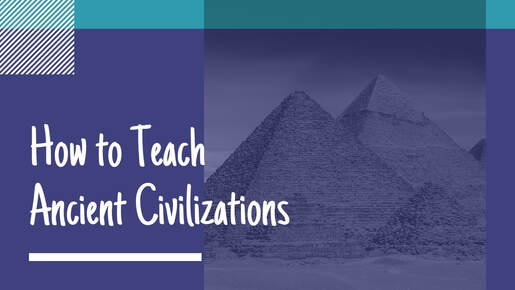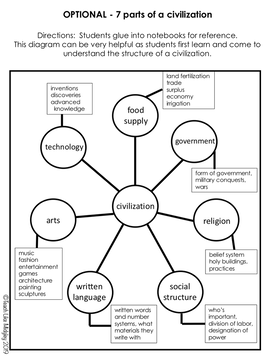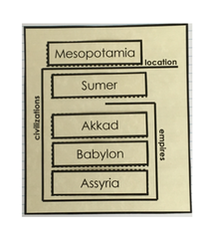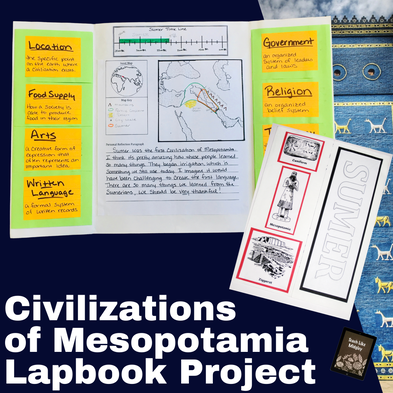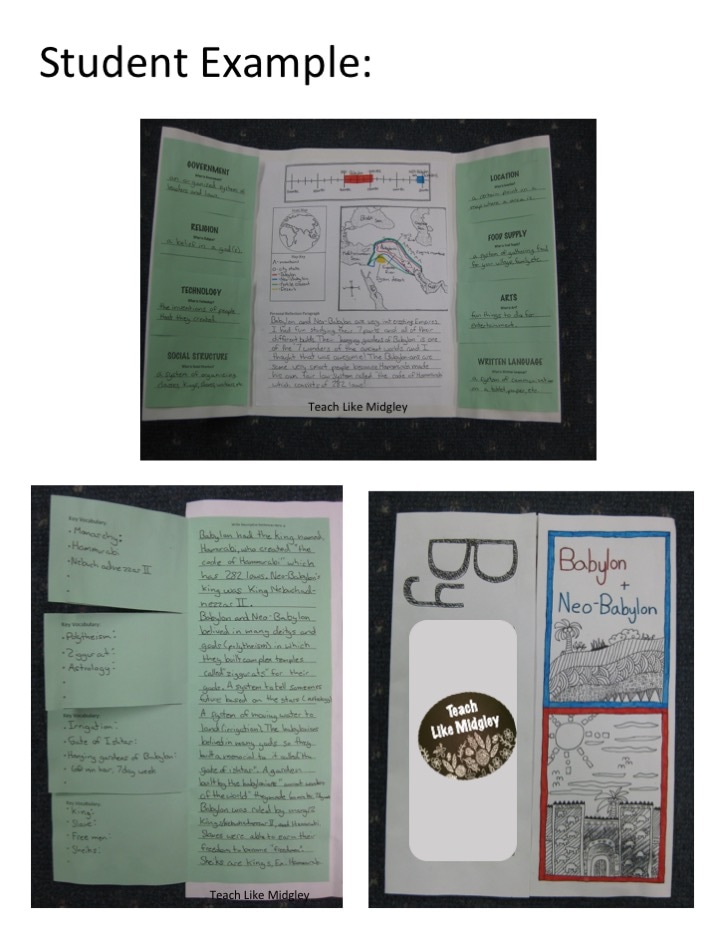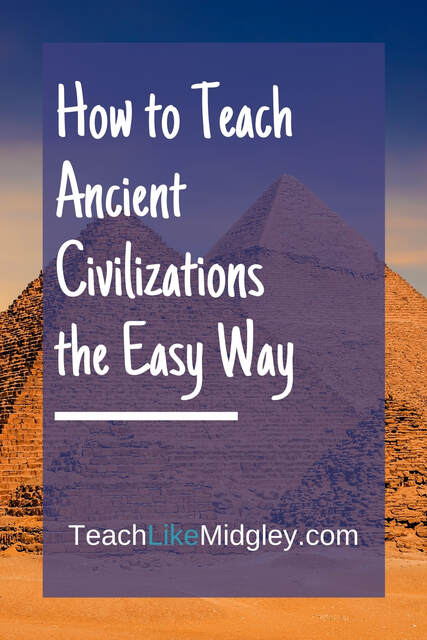How to Teach Ancient Civilizations
with a 7 Part Structure
How do you structure your history lessons to make things more tangible and provide direction for your students?
I have been teaching about ancient civilizations for years. I truly love the content – but let’s face it, there is a lot of new information for 6th graders with this curriculum. The year I discovered History Alive! By Teachers Curriculum Institute was an amazing year for me. Unfortunately, our district chose not to purchase this curriculum. However, the text used topics to discuss each civilization – government, religion, food supply, social structure, written language, arts, & technology.
As I poured through this text, I realized this was the structure I needed for my students. In addition to these “seven parts” I would also include a component that I labeled, location. I did not use it as one of the parts of a civilization because having a location simply makes for a settlement.
I have been teaching about ancient civilizations for years. I truly love the content – but let’s face it, there is a lot of new information for 6th graders with this curriculum. The year I discovered History Alive! By Teachers Curriculum Institute was an amazing year for me. Unfortunately, our district chose not to purchase this curriculum. However, the text used topics to discuss each civilization – government, religion, food supply, social structure, written language, arts, & technology.
As I poured through this text, I realized this was the structure I needed for my students. In addition to these “seven parts” I would also include a component that I labeled, location. I did not use it as one of the parts of a civilization because having a location simply makes for a settlement.
So I approached my colleague about the idea of structuring our units, our lessons, and our assessments around the seven parts of a civilization. He thought it was a fantastic idea – and so we got to work taking materials we already had, and fitting them into the structure.
With every topic we discussed in class, we categorized it into the seven parts. Some of these topics would naturally overlap.
For example: Sumer was the first civilization to create cuneiform – which is obviously categorized in written language, but could also be argued as a technology, a new invention.
It seemed fitting that both categories would be acceptable – especially with a well, reasoned explanation.
Our students thrived on this structure. It gave them a focus in their studying. Instead of wondering if they were studying all the material before the test – they could be confident in knowing as long as they were familiar with the seven parts of the current civilization of study, they were on the right track.
Something I really loved about this structure – is that it forced students to think critically. They had to justify their reasons for their categorizing. Which means they had to be very familiar with the content.
With every topic we discussed in class, we categorized it into the seven parts. Some of these topics would naturally overlap.
For example: Sumer was the first civilization to create cuneiform – which is obviously categorized in written language, but could also be argued as a technology, a new invention.
It seemed fitting that both categories would be acceptable – especially with a well, reasoned explanation.
Our students thrived on this structure. It gave them a focus in their studying. Instead of wondering if they were studying all the material before the test – they could be confident in knowing as long as they were familiar with the seven parts of the current civilization of study, they were on the right track.
Something I really loved about this structure – is that it forced students to think critically. They had to justify their reasons for their categorizing. Which means they had to be very familiar with the content.
Part of the challenge was – how to introduce this structure to students. It would definitely need to happen in our first unit of study – the civilizations of Mesopotamia.
During our unit of Mesopotamia – we studied the location first, and what allowed that location to provide people with a stable food supply.
During our unit of Mesopotamia – we studied the location first, and what allowed that location to provide people with a stable food supply.
|
As a class, we discussed the first civilization, Sumer and the culture of the people. After learning about Sumer for 3 days – I introduced the 7 parts. Using a Bubble Map on the board, while students wrote in their notebooks, we labeled the center with civilization and I guided the students with labeling the seven bubbles around it. As we labeled these bubbles, we included information about what we already knew for Sumer.
|
It was well received. Students were at first a little worried – these seven parts seemed a little overwhelming. But as we filled in the information that we already knew – the information started to become more clear to students.
For the most part, we simply wrote in the information for Sumer. But when we reached technology, and especially the arts, I felt it was important to list out general examples for students to fully understand the concept.
After the bubble map, we read a short, information brief about the major civilizations in Mesopotamia: Sumer, Akkad, Babylon, & Assyria. Yes, there are others, but these are arguably pretty significant and to add more to the list would be overwhelming for 6th graders.
|
To help students understand that Mesopotamia is the name of a location, while Sumer, Akkad, Babylon, & Assyria were civilizations and also include the distinction of empires, we drew the following chart in our notes. This visual helped significantly with student understanding. |
After this introductory lesson, we spent three days, exploring Akkad, Babylon, & Assyria. When we were done, all students had basic information in their notebooks on all three, and they were ready to start their first major project of the year.
For years I would have students partner and create a poster for one of the three empires. I discovered 2 major challenges with this approach:
#1 – Too many students are absent from school. It was not fair to either partner. I really wanted each student held responsible for the work. But I knew it was too much for students to do individually.
#2 – Although I outlined expectations and requirement for the poster, it was too lax in structure.
I needed a new plan. A new project. The objective was good. I still wanted the end result. And so I discovered – Dinah Zike and her wonderful world of foldables.
Solution to Problem #1 – I decided to allow students to work with partners for the research aspect of the project (two days research time). But I required each student to make their own foldable (two days work time).
Solution to Problem #2 – I created my own templates to put into the foldable. And of course I made a teacher example project, using Sumer. The templates clearly outlined what information was required, but still allowed for student creativity in certain areas.
The final products were beautiful!
#1 – Too many students are absent from school. It was not fair to either partner. I really wanted each student held responsible for the work. But I knew it was too much for students to do individually.
#2 – Although I outlined expectations and requirement for the poster, it was too lax in structure.
I needed a new plan. A new project. The objective was good. I still wanted the end result. And so I discovered – Dinah Zike and her wonderful world of foldables.
Solution to Problem #1 – I decided to allow students to work with partners for the research aspect of the project (two days research time). But I required each student to make their own foldable (two days work time).
Solution to Problem #2 – I created my own templates to put into the foldable. And of course I made a teacher example project, using Sumer. The templates clearly outlined what information was required, but still allowed for student creativity in certain areas.
The final products were beautiful!
The basic outline of my Mesopotamia unit –
1 – Discuss location and food supply
2 – Learn about Sumer
3 – Introduce the seven parts and the other major civilizations
4 – As a class, gather basic information on the other civilizations
5 – Pair up students to research and produce a foldable about their assigned civilization
6 – Students share their projects
7 - Review the key points for each civilization before wrapping up the unit
* Important Point about Partnerships! For this project, I take into account student academic levels, often using their reading level as a guide.
Students working at grade level are assigned the empire of Assyria.
Students working below grade level are assigned the empire of Akkad, because it is so similar to Sumer, the civilization we had already been studying together.
Students working above grade level are assigned the empire of Babylon. Babylon existed at two different time periods, which adds a bit of a challenge for them. Although 4 of the parts remain the same, there are extra pieces to add for government, technology & arts.
Sharing Projects:
The day the project is due, I have students share their projects with each other. There are obviously many ways to do this. I like to have students focus on the accomplishments and contributions of each empire, and at the end reflect on which one they felt was the most significant.
Before turning in the project:
On the back of the project, students have to answer 4 reflection questions for me:
I have been successfully teaching using the seven part structure for seven years now. I believe it to be very successful. And I always get positive feedback from students on this particular project! Give it a try!
1 – Discuss location and food supply
2 – Learn about Sumer
3 – Introduce the seven parts and the other major civilizations
4 – As a class, gather basic information on the other civilizations
5 – Pair up students to research and produce a foldable about their assigned civilization
6 – Students share their projects
7 - Review the key points for each civilization before wrapping up the unit
* Important Point about Partnerships! For this project, I take into account student academic levels, often using their reading level as a guide.
Students working at grade level are assigned the empire of Assyria.
Students working below grade level are assigned the empire of Akkad, because it is so similar to Sumer, the civilization we had already been studying together.
Students working above grade level are assigned the empire of Babylon. Babylon existed at two different time periods, which adds a bit of a challenge for them. Although 4 of the parts remain the same, there are extra pieces to add for government, technology & arts.
Sharing Projects:
The day the project is due, I have students share their projects with each other. There are obviously many ways to do this. I like to have students focus on the accomplishments and contributions of each empire, and at the end reflect on which one they felt was the most significant.
Before turning in the project:
On the back of the project, students have to answer 4 reflection questions for me:
- Do you feel you knew enough about your empire and could answer your classmates’ questions? Why or why not?
- Do you feel your classmates had enough information to share with you? Why or why not?
- What grade do you feel you deserve on your project? Why?
- What did you like or not like about this project? Why?
I have been successfully teaching using the seven part structure for seven years now. I believe it to be very successful. And I always get positive feedback from students on this particular project! Give it a try!
Need Some Done-For-You Resources?
+ Ancient Mesopotamia Planning Checklist for the 7 Part Structure
+ Ancient Mesopotamia Lesson Set Bundle
+ Ancient Mesopotamia Lap-Book Project with Templates
+ Ancient Mesopotamia Lesson Set Bundle
+ Ancient Mesopotamia Lap-Book Project with Templates
Looking for more on how to incorporate the 7 parts into your lesson planning?
Then these next posts are for you...

Welcome! I'm Hillary Midgley, a veteran 6th grade teacher.
I create educational materials and develop curriculum for other teachers. I specialize in teaching students how to learn through my Study Skills Curriculum. I have established fundamental classroom systems and structures for teachers to help them streamline their classroom. And my passion is teaching ancient history through engaging activities with foundations in academic skills. Here you will find resources on all of these topics and more. Learn more about me here.
*Teach Like Midgley contains affiliate links with Amazon. See full disclosures.
|

